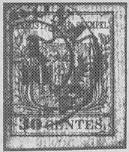The ribbed paper

Fig. 1: 45 centesimi first type
In 1851 the 15 centesimi (1st
and 2nd type), the 30 centesimi (1st type) and the 45 centesimi (1st type)
stamps were printed in handmade paper of the type called "with ribs"
or "ribbed".
The reason of the choice of that type of paper (or better of type of manufacturing)
is not yet fully understood. In fact it has been proven that the paper got
this treatment AFTER being printed. Therefore the paper in origin was flat
(usual handmade paper) but, for not clear reason, was later on subjected to
this treatment. We can make that hypothesis (Emilio Diena, "Regno
Lombardo Veneto") that it has been done to make more evident the
cancellations and the marks left in case of cancellations trail for fraudulent
reuse. Another theory is that they were ribbed to make the part identifiable
to the first sight, because starting 1853 dangerous forgeries were put in
the market. Unfortunately this theory forgets the small detail that the ribbed
stamps were put in commerce in 1851 and they were used up in 1852, well before
the first forgeries came to light...
Probably the sheets of the printed stamps were pressed with a metallic cylinder
"ribbed" that embossed this characteristic. During this process
was not unusual for the sheets of paper to bend themselves creating strong
creases on the stamps. As average the ribs have a thickness of 0.3 mm and
we can count around 30 ribs every 2 cm of paper.
This treatment of ribbing, probably also for the difficulties of implementation,
was quite soon abandoned. We should note that some of the sheets got the ribbing
on the stamp side and other on the gum side; therefore it is always appropriate
to check the parts with lateral light and on both sides...
NOTE:
because the scanner is not capable to put easily in evidence this "tri-dimensional"
variety it's for me impossible to publish images where this characteristic
comes out in clear way .The Fig. 1 itself (kept by choice very dark)
that represents a sample with very strong ribbing, looks at the first sight
the one of an usual part; by making an effort we can barely see the ribbing,
mainly on the top an lateral white part of the piece. Here below I show two
images (Fig. 2 - Fig. 3) taken from catalogues where it's possible
to see more clearly this characteristic.

Fig. 2: 30 centesimi
(from "Catalogo C.E.I." ed. 2000/01)
